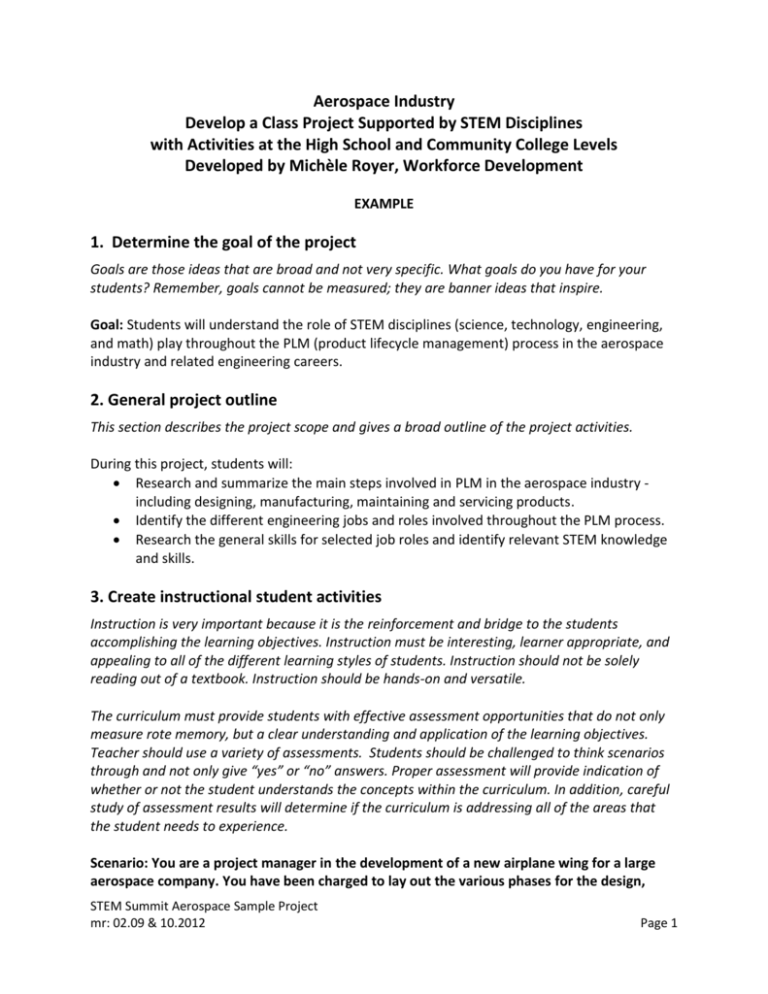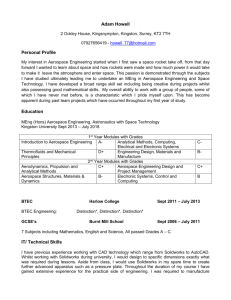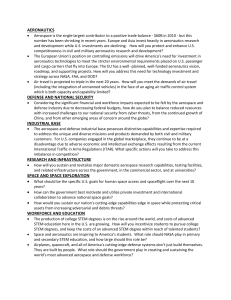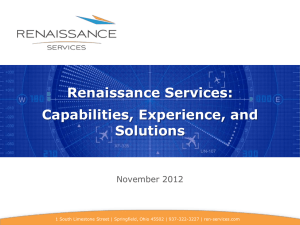Lean-Manufacturing-in-Aerospace-Advanced
advertisement

Aerospace Industry Develop a Class Project Supported by STEM Disciplines with Activities at the High School and Community College Levels Developed by Michèle Royer, Workforce Development EXAMPLE 1. Determine the goal of the project Goals are those ideas that are broad and not very specific. What goals do you have for your students? Remember, goals cannot be measured; they are banner ideas that inspire. Goal: Students will understand the role of STEM disciplines (science, technology, engineering, and math) play throughout the PLM (product lifecycle management) process in the aerospace industry and related engineering careers. 2. General project outline This section describes the project scope and gives a broad outline of the project activities. During this project, students will: Research and summarize the main steps involved in PLM in the aerospace industry including designing, manufacturing, maintaining and servicing products. Identify the different engineering jobs and roles involved throughout the PLM process. Research the general skills for selected job roles and identify relevant STEM knowledge and skills. 3. Create instructional student activities Instruction is very important because it is the reinforcement and bridge to the students accomplishing the learning objectives. Instruction must be interesting, learner appropriate, and appealing to all of the different learning styles of students. Instruction should not be solely reading out of a textbook. Instruction should be hands-on and versatile. The curriculum must provide students with effective assessment opportunities that do not only measure rote memory, but a clear understanding and application of the learning objectives. Teacher should use a variety of assessments. Students should be challenged to think scenarios through and not only give “yes” or “no” answers. Proper assessment will provide indication of whether or not the student understands the concepts within the curriculum. In addition, careful study of assessment results will determine if the curriculum is addressing all of the areas that the student needs to experience. Scenario: You are a project manager in the development of a new airplane wing for a large aerospace company. You have been charged to lay out the various phases for the design, STEM Summit Aerospace Sample Project mr: 02.09 & 10.2012 Page 1 development and manufacturing of the wing using the PLM (product lifecycle management) process, as well as recruit the necessary professionals. 3.1 Instructional experience for high school students 1. Students will be given resources to study before the start of each activity: internet articles, or recorded or live interview of an industry professional discussing the main components of an airplane wing and the basic characteristics of PLM. 2. In-class, students will brainstorm the main components of an airplane wing and the main phases of development and manufacturing (example wing design and modeling, materials selection, aerodynamics design, wind tunnel testing, safety testing, electronics, sensors and actuators, manufacturing process, maintenance…) 3. Each student or group of students will focus on one phase of the development, manufacturing or maintenance (example: structural design) and identify skills and roles needed to support this part of the development, manufacturing or maintenance. 4. Based on the identified skills and roles, each student/student team selects a relevant engineering job (example: structural design engineer) and identify STEM skills that support the job responsibilities. Students will be given related sample job descriptions to study. 5. Discuss which STEM knowledge and skills would be needed to support these jobs and which high school courses would form a strong foundation for these jobs. Possible assessments Students write a report and deliver a presentation of their findings and analysis in activity 1 – thoroughness of analysis and clarity of presentation. Students write a brief report on their findings in activities 3 & 4 – clarity and organization of the report, thoroughness of the analysis. Students write a short reflection of their team experience, what worked well, what was most challenging, what they would personally do differently to be a stringer contributor, what they have learned from the experience. Students participate in class discussion in activities 2 & 5 – clarity of statements and questions, respect for other students’ participation and perspective. 3.1 Instructional Experience for community college students 1. Students will be asked to conduct research on airplane wing design and the PLM process on the internet and/or be asked to interview industry professionals. 2. In-class, students will brainstorm the main components of an airplane wing and the main phases of development and manufacturing (example: wing design and modeling, materials selection, aerodynamics design, wind tunnel testing, safety testing, electronics, sensors and actuators, manufacturing process, maintenance...) 3. Each student or group of students will focus on one phase of the development, manufacturing or maintenance (example: structural design) and identify skills and roles needed to support this part of the development, manufacturing or maintenance. STEM Summit Aerospace Sample Project mr: 02.09 & 10.2012 Page 2 4. Based on the identified skills and roles, each student/student team selects a relevant engineering job (example: structural design engineer) and identify STEM skills that support the job responsibilities. 5. Using dice.com or indeed.com, students research the skills and qualifications for these jobs. 6. Discuss which STEM knowledge and skills would be needed to support these jobs and draft education pathways for these careers. Possible assessments Students write a report and deliver a presentation of their findings and analysis in activity 1 – thoroughness of analysis and clarity of presentation. Students write a brief report on their findings in activities 3, 4 & 5 – clarity and organization of the report, thoroughness of the analysis. Students write a short reflection of their team experience, what worked well, what was most challenging, what they would personally do differently to be a stringer contributor, what they have learned from the experience. Students participate in class discussion in activities 2 & 6 – clarity of statements and questions, respect for other students’ participation and perspective. 4. Explore ways the High School and Community College students can connect and collaborate CC students could share with HS students which HS courses were most valuable as a foundation to their aerospace-related program of study; and which courses they wished they had taken. HS students could query CC students as to why they chose an aerospace- related education pathway. Possible internet resources: http://en.wikipedia.org/wiki/Product_lifecycle_management http://en.wikipedia.org/wiki/CATIA http://tech-clarity.com/clarityonplm/tag/aerospace/ http://www.plmsa.co.za/disciplines/general/2-plm-primer.html http://www.sti.nasa.gov/tto/Spinoff2010/t_5.html http://en.wikipedia.org/wiki/Fixed-wing_aircraft STEM Summit Aerospace Sample Project mr: 02.09 & 10.2012 Page 3






